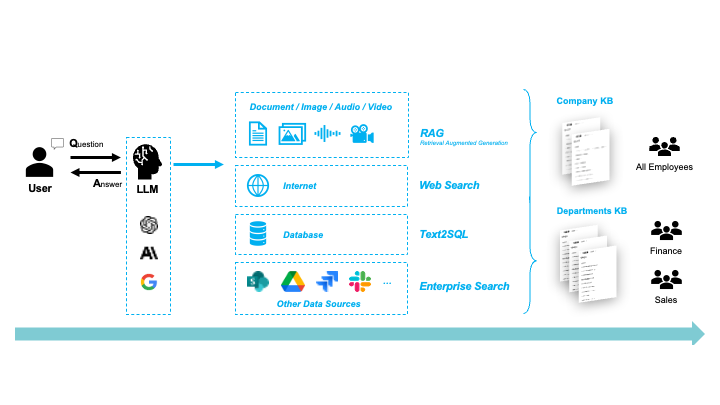With the rapid development of Artificial Intelligence (AI), its applications are now seen everywhere — not only in our daily lives but also deeply integrated into modern business operations.
AI demonstrates tremendous potential in areas such as data analysis, customer service, and process automation. By adopting AI, organisations can:
-
Increase employee productivity
-
Significantly reduce operational costs
-
Strengthen competitiveness
-
Unlock new business opportunities
As AI technology continues to advance, its enterprise use cases are expanding rapidly. Companies are moving beyond simple data consolidation to automated report generation, enabling faster, data-driven decisions and more convincing business strategies.
The key question for enterprises is: How can we build an AI-powered “business advisor” to make faster, smarter, and more efficient decisions based on real-time data?
When ChatGPT first launched at the end of 2022, it introduced the world to conversational AI. Unlike a search engine, ChatGPT can respond to almost any query in natural language.
As global tech giants began competing to develop large language models (LLMs) and millions of users started experimenting with these tools, enterprises were slower to adopt them internally.
The main challenge lies here:
LLMs cannot access a company’s internal data directly, making it difficult to answer business-specific questions or provide tailored insights.
To solve this, organisations can follow three key steps to connect AI with both internal and external data, transforming it into a powerful tool for decision-making.
Step 1: Transform Information into Actionable Knowledge
To enable AI to effectively utilise company data, you must first convert various file types into a machine-readable format. Technologies such as Retrieval-Augmented Generation (RAG) are essential here.
Challenges at this stage include:
-
Many companies’ internal systems are still limited to basic text recognition.
-
For complex files — such as PDFs containing images, charts, and tables — incomplete data extraction will reduce the accuracy and completeness of AI responses.
-
For audio and video files, processing becomes even more complex and resource-intensive.
In addition to internal documents, enterprises need to integrate:
-
Real-time external data from public sources
-
Internal systems such as CRM, ERP, and proprietary databases
-
Web-based information feeds
Finally, role-based access control should be implemented to ensure different departments only access data relevant to their functions, maintaining data security and compliance.

Example: Investment Research Analyst
Traditionally, a research analyst preparing an investment report must:
-
Investigate company backgrounds
-
Analyse financial reports
-
Monitor dynamic data such as stock prices, breaking news, and social media trends
This process typically takes weeks or even months.
With an AI model connected to internal and external data, the analyst can:
-
Ask targeted questions in natural language
-
Instantly retrieve the required data and reports
-
Reduce time spent searching, reading, and consolidating information
Step 2: Deep Research for In-Depth Understanding
Once AI can consolidate all relevant data, the next step is to shift from reactive responses to proactive intelligence.
Currently, most AI systems still require users to issue step-by-step prompts.
The goal of Deep Research is to give AI the ability to:
-
Plan tasks independently based on a given topic
-
Determine the types of data needed
-
Execute workflows automatically
-
Deliver comprehensive reports without constant user intervention
.png)
Scenario:
Imagine the same analyst submits a report, and the manager requests research on a different topic.
Without Deep Research, the analyst must:
-
Repeat the entire data collection process
-
Re-analyse and rebuild the report manually
With Deep Research, the AI:
-
Suggests relevant data sources
-
Designs an outline for the report
-
Automatically compiles and summarises findings
-
Outputs a final report, ready for review
This significantly increases efficiency while reducing repetitive work.
Step 3: From Knowledge to Action
Producing a detailed report is valuable, but actionable outcomes are the ultimate goal.
By integrating plugins and external tools, AI can move beyond generating reports to executing tasks automatically, such as:
-
Updating calendars
-
Triggering workflows in external systems
-
Performing operations like booking services or sending notifications
.png)
Example: Business Trip Planning
An AI system could:
-
Gather all necessary information, such as schedules, budgets, and locations
-
Generate an optimised itinerary
-
Automatically:
-
Book flights
-
Reserve hotels
-
Update calendars and notify relevant team members
-
This demonstrates the full evolution of AI: Data → Knowledge → Insight → Action
Conclusion
As AI technology continues to evolve, enterprises no longer have to passively consume information.
Instead, they can actively transform raw data into trusted insights and meaningful actions.
By following these three steps:
-
Information organisation
-
Deep research
-
Execution and automation
Businesses can:
-
Accelerate decision-making cycles
-
Improve accuracy and confidence
-
Identify hidden opportunities
Now is the ideal time to build an AI-powered decision assistant, making smart technology a core driver of innovation and growth.
Recommended AI Tool for Enterprises – NAVI
NAVI is an AI knowledge management system designed for enterprise operations.
It provides a comprehensive suite of capabilities, including:
-
Knowledge base management
-
Customer service chatbots
-
Video analytics and insights
Key strengths:
-
Supports multiple LLMs (Large Language Models)
-
Seamlessly integrates with third-party systems
-
Simplifies deployment and accelerates adoption
With NAVI, businesses can:
-
Streamline knowledge management
-
Enhance decision-making efficiency
-
Drive digital transformation success
Partner with Netron for Your AI Journey
Adopting AI is no longer an ambitious dream.
With a trusted cloud service partner like Netron, enterprises can:
-
Rapidly integrate AI into workflows
-
Accelerate cloud migration and deployment
-
Simplify IT operations and management
-
Unlock the cloud’s potential to increase efficiency, reduce costs, and capture new opportunities
Contact Netron today to explore cloud solutions and success stories, and start your journey towards an intelligent, future-ready enterprise.